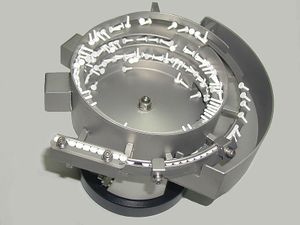Vibratory Drive Units
Vibratory Bowl Feeders are the most common devices used to feed individual components in Industrial Assembly Automation Applications. Vibratory Feeders are self-contained systems, comprising a specially tooled [Bowl Feeders|bowl feeder]] that orients the parts, a vibrating drive unit, upon which the bowl feeder is mounted, and a variable-amplitude control box. The bowl feeder, including an out feed accumulation track to convey parts along and discharge into the assembly machine comes in many shapes and sizes. The drive unit, available in both electromagnetic and pneumatic drives, vibrates the bowl feeder, forcing the parts to move up a circular, inclined track.
The track is designed to sort and orient the parts in consistent, repeatable positions. The track length, width, and depth are carefully chosen to suit the application and component shape and size. Special track coatings are applied according to shape size and material of the component which aids traction, damage to the product and lower acoustic levels. A variable speed control box is used for controlling the vibration of the bowl feeder and stops the flow of parts to the out feed track via sensors. Vibratory feeders are utilized by all industries including, the pharmaceutical, automotive, electronic, food, Fast Moving Consumable Goods (FMCG), packaging and metal working industries. It also serves other industries such as glass, foundry, steel, construction, recycling, pulp and paper, and plastics. Vibratory feeders offer a cost-effective alternative to manual labor, saving manufacturer’s time and labor costs. Several factors must be considered when selecting a parts feeder, including the industry, application, material properties and product volume.
The vibrator which drives the bowl is called Vibrating Drive Units. These can be from 65 mm diameter to upto 1200 mm diameter in case of electromechanical coil types.
Video
